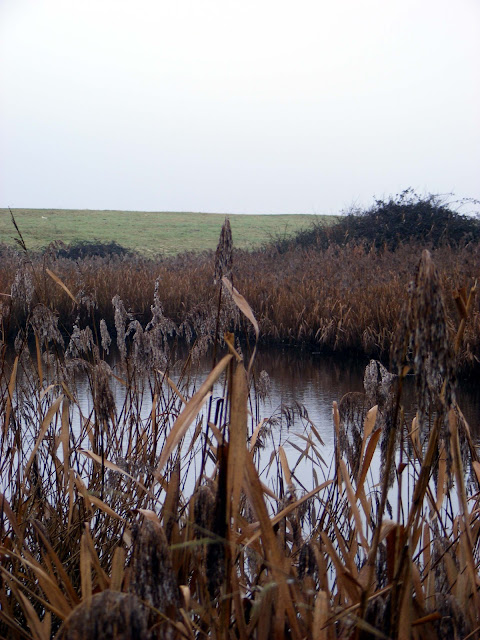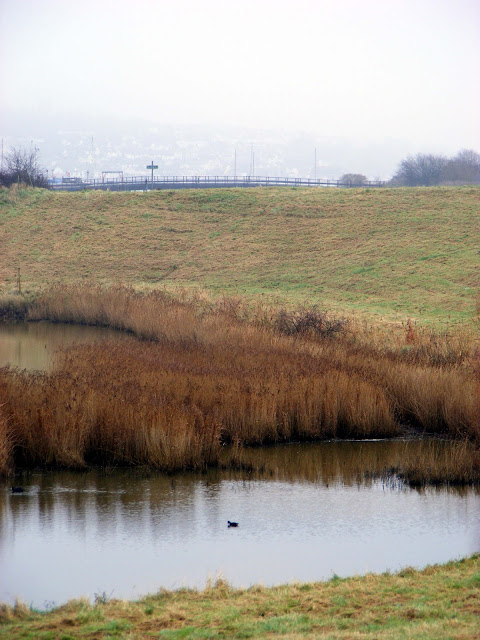In Roman times the reclaimed area which is now Canvey Island was joined to the mainland by a road providing access from Benfleet at low tides to Camulodunum (Colchester) and Londinium (London).
The Battle of Benfleet took place between the Vikings and Saxons in 894. This was towards the end of the Saxon period, and the Thames and other waterways made the area vulnerable to Viking attacks. Benfleet was used as a Viking base.
I walked along the road and crossed by the bridge that goes over to Canvey Island, I continue along the creek past the flood barrier towards Hadleigh.
I choose to follow the estuary for now and cross over to Hadleigh Castle further up. The ground was unbelievably muddy and the fact that scrambler bikes had churned up the ground judging by the tyre tracks.
I could just make the castle out through the mist.
Hadleigh Castle was first built by Hubert de Burgh, the 1st Earl of Kent, who was a key supporter of King John. De Burgh was given the honour of Rayleigh by John in 1215 as a reward for his services, but chose not to develop the existing caput of Rayleigh Castle, instead building a new fortification south of the town of Hadleigh.
The castle was built of Kentish ragstone and cemented by a mortar containing a large proportion of seashells, particularly cockleshells from the cockle beds of neighbouring Canvey Island. De Burgh finally fell out of favour with Henry III; he was imprisoned and then finally stripped of Hadleigh Castle in 1239.
I continued back along the estuary,having no choice after my plans were changed.
I am walking alongside Two Tree Island towards Leigh On Sea. Two Tree Island was reclaimed from the sea in the 18th Century by building a sea-wall around saltmarsh. It was used for rough grazing until 1910 when a sewage farm was built on its eastern tip. In 1936 Southend Borough Council acquired the whole island with the object of using it as a rubbish tip. In 1974, having completed tipping on the eastern part of the island, the Council granted a long lease to the Nature Conservancy Council (now English Nature) covering the reserve as it now stands, and it was designated a National Nature Reserve.
 |
| Road Bridge over to Two Tree Island |
I walked over the bridge onto Two Tree Island, but decided I didn't have time today to have a look about and will come back another day.
 |
| Turnstones resting on a boat |
I now leave old Leigh On Sea and walk along the coast towards Chalkwell.
The Crow Stone, which stands on the mud on the estuary foreshore opposite the end of Chalkwell Avenue, marks the limit of the Port of London Authority's jurisdiction. It was erected in 1837 and replaced a smaller stone, dating from 1755. The older stone was removed to Priory Park in Southend where it remains today. The line, known as the Yantlet Line, between the Crow Stone and the London Stone, Yantlet Creek, almost due south on the other bank of the Thames is used as the eastern boundary of the jurisdiction of the Port of London Authority.
 |
| A Black Headed Seagull in Winter Plumage. |
 |
Former HMS Wilton |
The world's first plastic [GRP] warship was the Royal Navy's HMS Wilton, a coastal minesweeper of about 450 tons.
The use of GRP gave the vessel a much lower magnetic signature, a good thing if hunting magnetic sea mines. Paid-off in 1994 she changed hands twice before moving to Leigh-on-Sea, on the north side of the Thames estuary near Southend where she is now the clubhouse of the Essex Yacht Club. The tide goes right out here so if you are prepared to get your feet muddy you can walk right around her at low tide and examine the construction methods used on her.
The interior has been renovated as a clubhouse but the former HMS
Wilton's diesel machinery is now owned by the Deltic Preservation
Society, which specialises in diesel locomotives. She retains her 40mm
Bofors cannon.
The two main theatres in Westcliff are the Cliffs Pavilion, which overlooks the seafront, and the Palace Theatre.
Westcliff-on-Sea is also home to the Thames Estuary Yacht Club and the Westcliff Casino, which is the largest provincial casino and the second largest casino in Great Britain.
 |
| Westcliff Hotel |
 |
| Genting Casino, Westcliff |
 |
| Southend Cliff Railway |
Now I enter Southend On Sea. The town is known for its seafront. Southend-on-Sea is home to the world's longest pleasure pier, built in 1830 and stretching some 1.33 miles from shore.
The Kursaal was one of the earliest theme parks, built at the start of the 20th century. It closed in the 1970s and much of the land was developed as housing. The entrance hall, a listed building, is a bowling alley arcade operated by Megabowl and casino. An amusement park, formerly known as Peter Pan's Playground, straddles the pier entrance. Peter Pan's Playground was eventually renamed Adventure Island as its size and popularity grew, and has since grown into a large amusement park with over 50 rides. The seafront also houses the "Sea-Life Adventure" aquarium, owned by the Miller family, who also own Adventure Island.
The cliff gardens, which included Never Never Land and a Victorian bandstand were an attraction until slippage in 2003 made parts of the cliffs unstable, and the bandstand has been removed. The council wants to re-erect the bandstand but a location has to be found.
A modern vertical lift links the base of the High Street with the seafront and the new pier entrance. The older Southend Cliff Railway, a short funicular, is a few hundred metres away.
I was saddened to see the old pirate ship at Adventure Island formerly Peter Pans Playground had vanished! All that was left was a burning pile of wood. I had fond memories of this as a child and the man with a axe swinging back and forth over is head.
I now make my way back through the shopping centre and to Southend Victoria Rail Station for the journey home.


















































